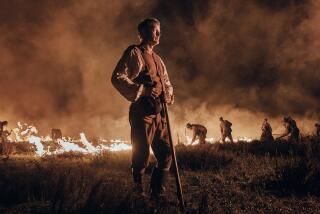Grimur Hakonarson’s ‘Rams’ tells a tale of estranged siblings and sheep

Grimur Hakonarson, from Iceland, is one of the directors attending this year’s Palm Springs International Film Festival. His latest film is “Rams.”
The snow falls hard, the sheep are tough and the brothers at the center of Grimur Hakonarson’s new film are as eccentric and stubborn as the windswept fields and battered sheds of their native Iceland.
“Rams” is the tale of a 40-year-old grudge between two sibling farmers who endure the seasons as if damaged men from a Raymond Carver short story. They grimace. They scoff. They peer at one another like aging gunslingers (or geriatric Vikings) in a battle over pride that ultimately collapses against the deeper bonds of family and survival.
The land is as unforgiving as the heart, but Hakonarson infuses enough subtle humor, including a dog that ferries handwritten notes between the warring parties, to conjure a rustic charm.
SIGN UP for the free Indie Focus movies newsletter >>
The brothers — Gummi and Kiddi — are drawn together after a livestock disease forces them to slaughter their sheep. The flocks were substitute families, and both men — one who drinks too much and the other who spends his nights putting together puzzles — are forced to desperate measures.
The movie was playing this week at the Palm Springs International Film Festival, and Hakonarson sat for a few questions about sheep, ice, national character and why Americans are so infatuated with dogs.
Much of “Rams” is about man’s battle against himself and the elements. It seems at once local and universal. What do these two hard-edged brothers represent?
It’s a relationship between brothers and between man and sheep. I thought when I started to write the script that the story of the brothers was a typical story for Icelanders because we tend to be a bit stubborn and independent and we don’t really want to rely on other people.
The film maybe describes our nation, an independent island in the middle of the ocean between the U.S. and Europe. I always thought it was a local Icelandic story, but it turns out to be these brothers are everywhere in the world. It was so much more universal than I thought.
The movie is comfortable in taking its time to let things unfold.
One of my artistic goals was to create the relaxed but stoic atmosphere in this kind of farming. We didn’t use a lot of music. There’s not much dialogue. There’s a lot of silence. These brothers are living this slow life. In pacing the film, I let a moment play naturally through the scene. The editing and the cinematography are slow paced. The are many elements we used to create this atmosphere. Everything should be real.
Your story mixes eccentric, understated humor with slow-building drama. How did you strike that balance?
I worked on the script for three years. I try to pick my stories with comic and dramatic elements. It’s tragic-comedy in its essence. Two brothers living closely together but not speaking for 40 years creates a lot of comic opportunities. The whole setup is a bit comic. If the story feels too heavy or too dramatic, I think this is not for me. I’m quite picky. It’s a very tricky balance. The humor [shouldn’t] take over the drama or destroy the emotional parts. That’s something I put a lot of work in.
The root of the animosity between the brothers is hinted at but never fully laid bare. The ending is also left open to interpretation. Why?
This is part of my directing style, not to over explain things. The ending is not explained totally. We get to know the brothers and their conflict. But they have a common interest, which is the sheep and the disease that threatens them and comes into their lives. This disease [known as scrapie] is maybe the most tragic thing in the life of Icelandic sheep farmers. It’s the biggest danger. Thirty years ago, we had three times more sheep; now we have only about 800,000.
How has the movie been received by international audiences?
There’s one thing I noticed about Americans: They sympathize a lot with the dog. They’re always wondering what happened to the dog. This is the only country I’ve been to where people think so much about the dog.
Twitter: @JeffreyLAT
More to Read
Only good movies
Get the Indie Focus newsletter, Mark Olsen's weekly guide to the world of cinema.
You may occasionally receive promotional content from the Los Angeles Times.











